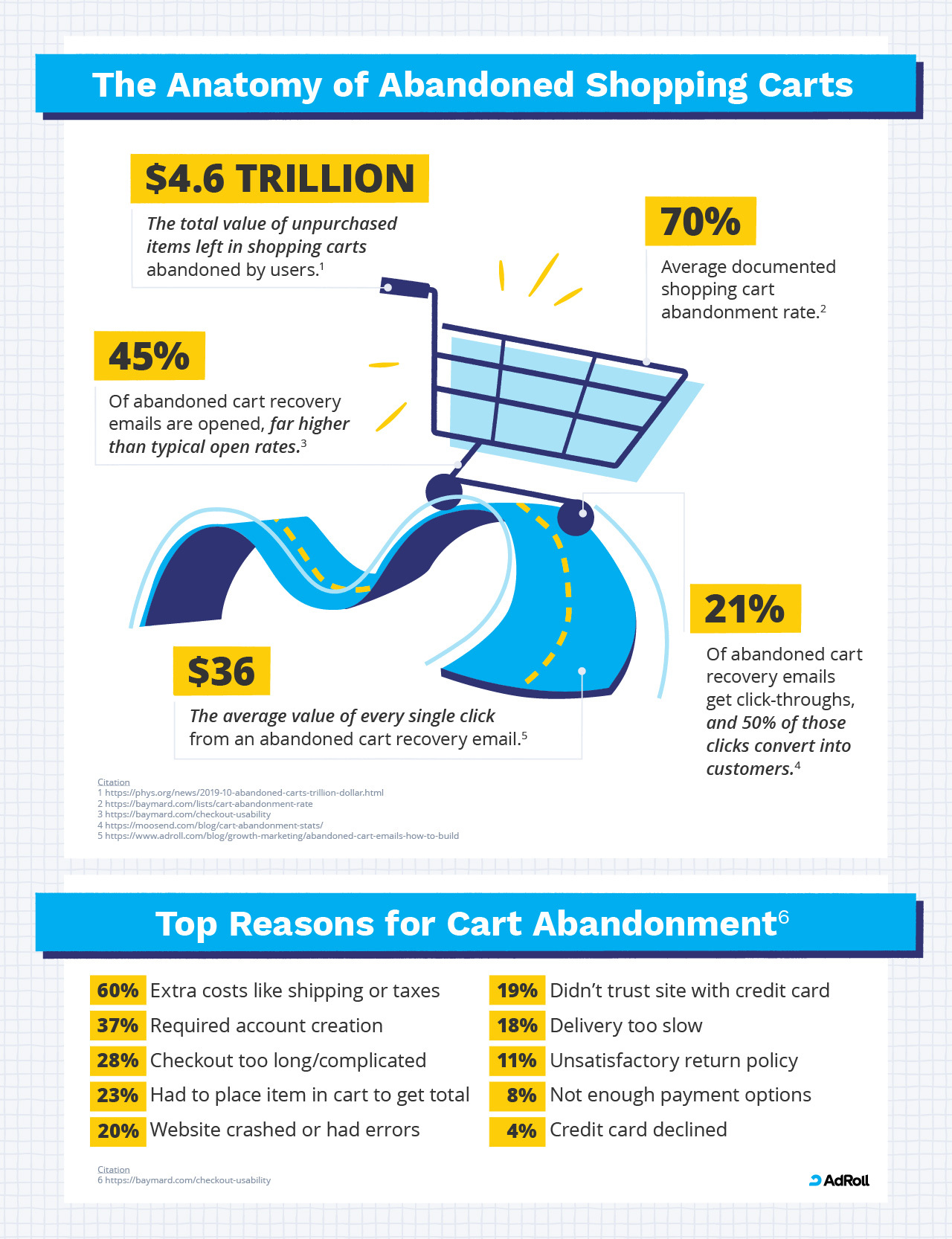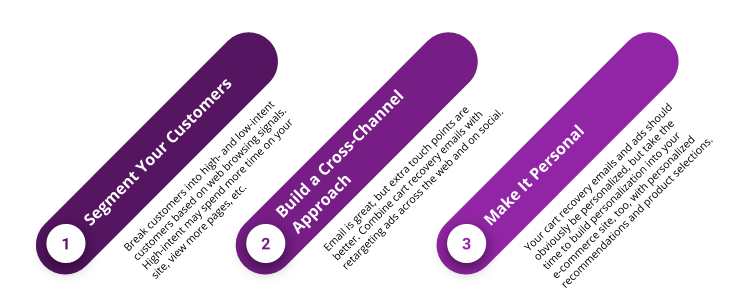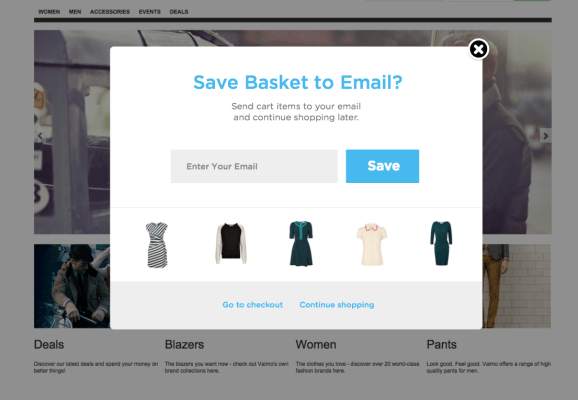The Ultimate Guide to Abandoned Carts
Are high abandoned cart rates hurting your sales numbers and cutting into your marketing budget? Check out this ultimate guide to recover these lost customers, personalize their experiences, and improve conversion rates.

Year 2020 has been one of unprecedented digital acceleration. While stuck at home, shoppers have become more comfortable with purchasing items online, from entertainment consoles to cozy loungewear. Unsurprisingly, the ecommerce space has transformed to make online shopping more accessible than ever — experiences such as waiting in line, sorting through crowded product racks, and overnight queuing for a product launch have become pain points of the past.
Yet, this embrace of ecommerce conveniences has led to a significant problem for retailers: shopping cart abandonment. Though pre-pandemic cart abandonment rates have always hovered at 70%, this number rose to 88.05% in March. It’s clear that people are spending more time aimlessly surfing the internet, clicking on ads, and adding items to carts with no intentions of checking out.
Without converting, these cart abandoners are eating up marketing budgets. Before that happens to your company, here’s everything you need to know about transforming a high abandoned cart rate into a statistic of the past.

Why Do Shoppers Abandon Their Shopping Carts?
A shopping cart abandonment rate higher than industry-wide numbers is a warning sign that something in your ecommerce pipeline needs work.
Common reasons why shoppers don’t check out include:
- Cost and price. According to Shopify, the most common reason for cart abandonment is unexpected costs during the checkout process, such as discounts that are limited to particular products or expensive shipping options. It helps to be transparent early on — make sure you clearly convey deals, add-on costs, and savings sitewide.
- Mobile experience. With more than 50% of consumers shopping online via mobile devices, it’s crucial that retailers optimize the checkout process for different device sizes. Shoppers will close the tab without hesitation if they feel frustrated by tiny forms that require pinching and zooming in.
- Lack of guest checkout option. While guest checkout is not the most desired checkout path from an ecommerce store’s perspective, no shopper would like to be forced to create an account or sign in before they can make a purchase.
- Product description. When product descriptions are confusing and wordy, shoppers may fail to fully grasp the value of what they’re about to purchase. It’s worth taking the time to review your product descriptions, ensuring they successfully alleviate apprehension, convey the product’s worth, and encourage buyers to snag the item while it lasts.
How Can You Avoid Shopping Cart Abandonment in the First Place?
Cart abandonment happens to all companies, from big-box retailers to small local businesses. But that doesn’t mean you can’t take active steps to reduce cart abandonment. Here’s how:
- Create a seamless checkout process. Optimize the shopping journey to make it as streamlined as possible — with every extra page or instruction, shoppers’ time (and patience) dwindles, making cart abandonment more likely. You can create the payment process more seamless by removing friction points, such as forcing shoppers to create an account before they can check out. Instead, allow them to check out as a “guest.” Additionally, you’ll want to check that loading times for pages are low, interfaces aren’t clunky or confusing, and customers can easily add and subtract items whenever they want. Pro tip: A progress bar can help set shoppers’ expectations for the checkout process.
- Provide helpful customer service. From chatbots to detailed FAQ pages, providing shoppers with easy-to-find answers regarding specific items, shipping and return policies, or payment options can help alleviate their doubts and boost their confidence to complete the purchase.
- Include different payment options. Consider implementing payment plan options, such as Klarna, Sezzle, or Afterpay, so shoppers can feel more comfortable about making large purchases.
For Shopify store owners, check out our Shopify abandoned carts combating guide for more tips.
How Do You Create an Effective Abandoned Cart Recovery Strategy?
To win over shoppers and push them toward the checkout button, retailers must develop strong abandoned cart recovery campaigns. This will require having a firm grasp of your customer journey, engaging with shoppers across marketing channels, and providing a personalized browsing experience. Additionally, as with any digital campaign, it’s crucial to continuously analyze the data you collect and test multiple strategies to see what works best.

1. Segment Your Cart Abandoners
Customer segmentation is the act of splitting up your shoppers based on specific demographics or behaviors. In the context of shopping cart abandonment, segmenting your shoppers can allow you to serve them better and more relevant messages and offers that aid cart recovery.
Here’s how to get started:
- Segmenting by cart value. Shoppers who add $800 worth of products in their cart should be treated differently than those with a $25 cart value. After segmenting by cart value, consider crafting retargeting campaigns with different messaging, design, and ad spend reflecting the intentions, factors of consideration, and buyer journeys of these contrasting shoppers. For example, for higher-value customers, your ads can include premium offers, such as one-on-one consultations or product customization. Comparatively, you can give smaller shoppers free shipping or a 5% discount.
- Segmenting by purchase history. By segmenting your cart abandoners based on purchase history — whether they are first-time or return shoppers — you can reward customer loyalty by offering a unique discount code with a message of appreciation. (It feels good when retailers acknowledge you!) Comparatively, you can target first-time shoppers with more aggressive conversion tactics, such as including more explicit product value propositions and serving higher ad frequencies.
- Segment by product. Craft a retargeting ad campaign based on specific products or product groups. For example, if a shopper abandons a cart that includes a gaming console (such as a Nintendo Switch), you can show them ads for popular games that may further pique their interest. (Who can resist a game like Animal Crossing?!) Segmenting by product provides the ability to add more context to your products.
Other ideas include segmenting according to how many times shoppers visited your site, where they abandoned their cart in the checkout process, or which site pages they had previously clicked on. It all depends on the data you have collected and what behavioral trends you see.
Ultimately, segmentation is an opportunity for more strategic A/B testing — different product images, headlines, and offers — so you can find the winning formula for cart recovery.
2. Create Your Abandoned Cart Email Campaign
Email is a reliable tool for targeting cart abandoners — it’s both a reminder and opportunity to encourage shoppers to finish their purchase. That’s why 46.1% of people open cart abandonment emails, which is significantly higher than typical branded emails.
Check out these best practices for abandoned cart email campaigns:
- Timing is everything. Experts suggest that initial emails that land in shoppers’ inboxes within an hour of them exiting the shopping process have the highest conversion rates. (That’s because your brand and product offerings are still fresh in their memory.)
- Keep it clear and concise. Since shoppers are already familiar with your brand, you’ll want to keep your messaging persuasive but short and punchy. In other words, skip the brand story, feature the products they showed interest in, and nail down your CTA. Of course, driving a sense of urgency by emphasizing that products are selling fast always helps. It’ll be well worth the time to experiment with different headlines (which are the most important component of any email campaign) to see what iterations successfully break through the noise and impact open rates.
- Sweeten the deal. Whether it’s by offering free shipping or a small discount, giving shoppers a compelling incentive to recover their carts will help your sales. After all, modern shoppers are accustomed to the practice of searching for the best value.
- Don’t be afraid to follow up. No longer are email retargeting campaigns a one-off affair. However, you’ll want to space your cart recovery email campaign out over several days to avoid being too spammy. Additionally, leverage a progression of messages — nobody wants to receive the same “you’ve forgotten these items” half a dozen times. You can start with a reminder, followed up by friendly encouragement to check out, and end with a deal sweetener.
3. Create a Multi-Channel Abandoned Cart Recovery Plan
There is no one-size-fits-all strategy for abandoned carts, but there is one feature that all successful cart abandonment campaigns share: their efforts span multiple channels.
Your strategy should reflect how the modern customer journey is fluid, encompassing dozens of touchpoints. In fact, our research shows that shoppers who are targeted with both emails and ads are twice as likely to convert. What’s more, they convert twice as fast as shoppers who see ads alone.
Therefore, after you’ve segmented your shoppers and designed your email campaign, it’s time to craft your abandoned cart retargeting ads that ideally live in a multitude of places, including social media and display on websites and search engines. Though traditional display ads are cheaper, dynamic display ads are a powerful tool that uses site data to personalize ad content for each unique shopper. Unsurprisingly, the average click-through rate for display ads is a measly 0.07%, but this rises to 0.7% for retargeting ads.
Simply put, retailers can’t afford to have an abandoned cart strategy that spans only one platform. If one messaging channel fails to reach a shopper, you’ll want to make sure that another channel triggers automatically.
To make your multi-channel abandoned cart recovery strategy more effective, here are a few tips:
- Have consistent messaging across all channels. The No. 1 success factor of any multi-channel campaign is a cohesive and consistent brand image and message across channels. This is especially important for an abandoned cart recovery campaign given that it targets a very specific group of audience.
- Coordinate timing across all channels. While abandoned cart recovery emails can be sent within an hour or two of cart abandonment, retargeting ads could frustrate shoppers when served immediately after cart abandonment. On the other hand, retargeting ads can be the perfect way to continue reminding your prospects about their abandoned products, keeping them engaged.
- Personalize content across both emails and ads. It’s no secret that personalization is a must for cart abandonment emails. The same goes to abandoned cart retargeting ads. Retargeting ads with personalized content is also known as dynamic ads. It’s recommended to follow these dynamic retargeting best practices while implementing dynamic ads.
- Capture email addresses. Your abandoned cart recovery plan is not complete without an effective strategy to capture your shoppers’ email addresses while they’re on your site.

4. Personalize the Web Experience for Return Shoppers
You heard it here first: Ecommerce personalization — namely better product recommendations tailored to each shopper — can decrease abandoned cart rates.
You’d probably remember seeing products featured in a carousel under a section such as “Inspired by your shopping trend” or “Based on items you viewed” on Amazon.com. Those products are tailored to your interest and curated by an AI-powered product recommendation system.
When your shoppers come back to your store, they expect to be treated as return customers. By featuring personalized product recommendations based on what they’ve shown an interest in, you can filter out irrelevant information and streamline their shopping experience in a way that makes them less likely to abandon their shopping carts again. And once your algorithms have nailed down what shoppers are looking for, you can recommend adjacent products or even upsell them on premium items.
How Do You Measure the Success of Your Abandoned Cart Recovery Campaign?
Before you launch any campaign, you have to measure your baseline. To calculate your current cart abandonment rate, simply divide the total number of finished transactions by the number of carts opened (in other words, purchases / add-to-cart). Subtract the result from 1, then multiply by 100 for the percentage.

For marketers who feel like math isn’t their strong suit, don’t worry: Most ecommerce providers, such as Bigcommerce or Shopify, automatically churn out your cart abandonment rate, so you don’t have to calculate it by hand. Performance analytics tools, including Google Analytics, also provide this number and further breakdowns.
Once you’ve calculated your baseline cart abandonment rate and launched a multi-channel abandoned cart recovery campaign, it’s important to figure out how to correctly attribute recovery rates.
Did an email or display ad influence this shopper to convert? Which channel should you invest more heavily in? Which one do you optimize? It’s easy to get lost in these calculations and analyses — when each channel tries to claim credit for influencing recovery rates, you may see duplicate conversions and inaccurate numbers.
Measuring your cross-channel efforts is the key to attribution, optimization, and determining your optimal media mix. Here are some popular attribution models that marketers use:
- Single-touch attribution. Either the first or last touchpoint that the shopper interacted with receives 100% of the credit.
- Linear attribution. Every touchpoint receives equal credit.
- Time decay attribution. Every touchpoint receives credit, with the last one receiving the most and the first receiving the least.
- U-shaped attribution. Both the first and last touchpoints receive 40% of the credit, and the remaining 20% is divided among the middle interactions.
- Data-driven attribution. This is when machine learning automatically assigns credit to the touchpoints across your marketing channels, with no manual calculation needed.
For more on attribution modeling, check out our Attribution Modeling Guide.
Get Started with AdRoll
For ecommerce brands, abandoned carts are a huge marketing opportunity. Instead of spending your marketing dollars targeting every potential shopper, you can aim for shoppers who have already demonstrated a keen interest in your products, making them more likely to convert.
And, with AdRoll, you can easily reach cart abandoners across online platforms. Cart abandoners who see or interact with both emails and ads are 2x as likely to convert and also convert 2x as fast. Our dashboard allows you to glean insights from your top-performing channels with no need for sorting through data and analytics on every individual channel.
If you’re ready to target those abandoned carts, learn more about AdRoll’s abandoned cart recovery solution.